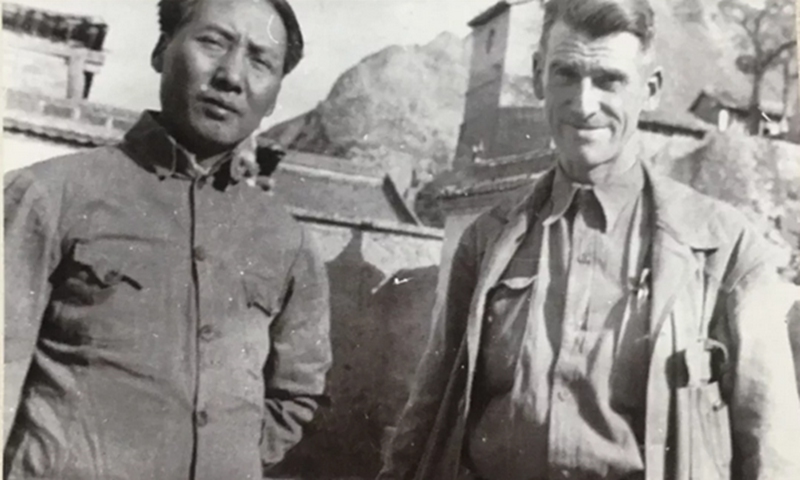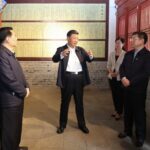Evans Fordyce Carlson was quite special among the foreign journalists to Yan’an. Other than being a passionate, committed journalist who risked his life marching and fighting with the Eighth Route Army, he was also a truth-seeking American military officer who brought the CPC’s art of war to the other side of the Pacific.
In September 1937, Edgar Snow returned to Shanghai from his secret visit to Yan’an. There he met Carlson, then a military observer of the Battle of Shanghai. After reading Snow’s draft Red Star Over China, Carlson became enchanted with what he saw in the book and decided to go to Yan’an himself. It was not easy, but Carlson managed to get a military pass. In Yan’an, he met Mao Zedong and other members of the CPC leadership. He also took a picture with Mao. In his memoirs, Carlson said Mao was a humble, kind and lonely genius who, in the darkness of the night, searched for peace and justice for his people.
After Yan’an, Carlson went to the Eighth Route Army headquarters in Shanxi. He had heart-to-heart talks with Zhu De and developed a family-like relationship with the Commander-in-Chief. Unlike other journalists, Carlson was very interested in how the CPC commanded and trained its army. To learn more about this, he moved from the headquarters to the frontline. By living, marching and even fighting with the Eighth Route Army soldiers, Carlson grasped the essence of guerrilla tactics – dispersion and covertness. He travelled with the guerrillas through the mountains in Western China, maneuvering with and fighting the Japanese based on information from the locals. Once a 700-strong Japanese taskforce sneaked into the resistance base. An Eighth Route Army squad followed the Japanese into a valley, where 500 Chinese soldiers were ambushing from a vantage point. The battle went on for a day and night and ended with 90 Japanese bodies and the rest fleeing. The Eighth Route Army reported zero casualty. Guerrilla tactics were so effective that the Eighth Route Army, even when outnumbered, were able to impose huge costs on the enemy with minimum loss of their own. Carlson also learned the importance of education, both political and tactical. The soldiers must understand the nature and objective of each operation and develop faith in the cause they were fighting for. That was the only way to build an army with loyalty, fortitude and courage. In an interception operation, Carlson tagged a squad for more than 90 kilometers overnight, where each soldier was loaded with 32 pounds of equipment. The hard trip took 32 hours and the combat mission was accomplished with great success. Even with the US Marine Corps training he had received, Carlson barely managed to keep up with the squad. He was astonished that none of the Chinese soldiers fell behind though they were as exhausted as he was. He asked one of them how he did it. The solider answered, a man with just two legs would fall behind, but he had two legs and his brain. He understood how great the War of Resistance against Japanese Aggression was, and he knew what the operation meant to the War. From the words of the soldier, Carlson saw the power of guerrilla tactics plus ideological education. When the soldiers joined forces, no enemy was invincible.
During his eight-month observation of China’s War of Resistance against Japanese Aggression, Carlson travelled more than 8,000 kilometers throughout Yan’an and all the resistance bases in Northern China. Based on his experience, he came to a world-shocking conclusion: the guerrilla tactics would lead China to victory and the CPC and the Eighth Route Army carried China’s hope.
Carlson was deeply impressed by the ideological education courses of the Eighth Route Army. There were no “officers and soldiers”, only “cadres and soldiers”. There was no distance among different ranks of the army, only trust between sworn brothers. Before each operation, a meeting would be held to brief the soldiers on the operation’s nature and objective as well as each person’s duty and potential risks. After the operation, they would analyze the causes of victory or defeat and how that particular operation was related to the overall objective – victory of the War of Resistance against Japanese Aggression. Everything here seemed different from the rigid hierarchy within the US army.
When the Pacific War broke out, Carlson was summoned back to US Marine Corps. Applying the military minds he gained in China, he created the close-combat Marine commando known as Carlson’s Raiders. Carlson broke with the US army conventions and introduced the Chinese communists’ egalitarian approach. He made himself a common soldier, standing guard, queuing in canteen and camping in the field. The Raiders, as the Chinese communists did, allowed every soldier to criticize the training arrangements during weekly meetings. Captain James Roosevelt, son of President Franklin Roosevelt, delivered situational reports as the political commissars did in the Eighth Route Army. Carlson combined guerrilla tactics and ideological education in training. He told his men why and who they were fighting for. Carlson’s raid on Japan’s at-sea supply depot Makin Island, a major victory of the US since it declared war on Japan, was a classic example of the Chinese communists’ raid tactics.
Carlson’s Raiders was a legend in WWII and Carlson, the Pacific War hero, was awarded three Navy Crosses. Stories of Carlson’s Raiders were made into movies and told around the world.
Physical disability resulting from the wounds in war caused General Carlson’s retirement in 1946. In his last days, Mao Zedong and Zhou Enlai sent letters of gratitude, in the name of the Chinese people, for his indelible contribution to introducing China’s democracy to the world. Carlson passed in May 1947. His “Chinese brother” Commander-in-Chief Zhu De sent his message of condolence. Evans Fordyce Carlson is always remembered by the Chinese people for his persistent pursuit of truth and justice, and for his sympathy and support to the revolutionary cause of the Chinese people.
Mao Zedong and Evans Fordyce Carlson



